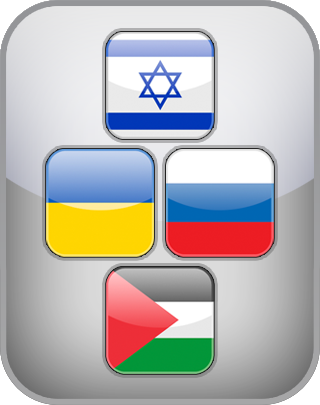Academically reviewed by Dr. Kellen Gracey, Ph.D. in political science
Conflict Coordinates Test
The recent re-eruption of hostilities in the Middle East has left the public scrambling to come to terms with two conflicts at once: Israel/Palestine and Russia/Ukraine.
This presents statements used to support Ukraine or Russia, Israel or Palestine, trawled from around the web using a big data approach.
In a generalized sense, which side(s) would you support in the two conflicts?
The Conflict Coordinates Test was developed by IDRlabs by trawling patterns in the most common arguments to support Israel, Palestine, Ukraine, and Russia online. The test should not be taken to reflect support for any side in these conflicts.
The conflict between Russia and Ukraine is a complex and multifaceted issue with a long history. The two countries have been at odds for centuries, and the current conflict is rooted in a number of factors, including:
The expansion of NATO: After the collapse of the Soviet Union, NATO expanded eastward, bringing it closer to Russia's borders. Russia has long seen NATO's expansion as a threat to its security.
The annexation of Crimea: In 2014, Russia annexed the Crimean Peninsula from Ukraine. This move was widely condemned by the international community, and it further strained relations between Russia and Ukraine.
The Donbas conflict: Since 2014, there has been an ongoing conflict in the Donbas region of eastern Ukraine. The conflict is between Ukrainian government forces and pro-Russian separatists.
The 2022 Russian invasion of Ukraine: In February 2022, Russia launched a full-scale invasion of Ukraine. The invasion has been met with widespread international condemnation, and it has caused a humanitarian crisis in Ukraine.
The Russia-Ukraine conflict is a major humanitarian crisis, and it is also having a significant impact on the global economy. The conflict has disrupted supply chains and caused energy prices to rise. It has also increased the risk of a wider war in Europe.
The Israeli-Palestinian conflict is a long-standing and complex conflict that has been ongoing for over a century. The conflict is rooted in competing claims to land and resources between the two groups.
The Israeli Declaration of Independence: In 1948, Israel declared its independence, and this led to the first Arab-Israeli war. The war resulted in Israel's victory and the displacement of hundreds of thousands of Palestinians.
The Six-Day War: In 1967, Israel occupied the West Bank, Gaza Strip, East Jerusalem, and the Golan Heights. This occupation has been widely condemned by the international community, and it has led to a number of Palestinian uprisings, known as intifadas.
The Oslo Accords: In the early 1990s, Israel and the Palestine Liberation Organization (PLO) signed the Oslo Accords. The Accords were aimed at achieving a two-state solution to the conflict, but they have largely failed to do so.
The Second Intifada: The Second Intifada, also known as the al-Aqsa Intifada, began in 2000. The Intifada was a period of widespread violence between Israelis and Palestinians.
The Gaza War: In 2008-2009, Israel launched a military operation against the Gaza Strip. The operation, known as Operation Cast Lead, resulted in the deaths of over 1,400 Palestinians.
The 2021 Gaza War: In 2021, there was a brief but intense war between Israel and Hamas, the militant group that controls the Gaza Strip. The war resulted in the deaths of over 250 Palestinians and 13 Israelis.
The Israel-Palestine conflict is a major humanitarian crisis, and it is also having a significant impact on the region. The conflict has caused widespread displacement and poverty, and it has also led to a number of human rights abuses.
Free online quizzes such as the present test do not provide professional assessments or recommendations of any kind; the test is provided entirely “as-is.” For more information about any of our online tests and quizzes, please consult our Terms of Service.

 English
English  Español
Español  Português
Português 